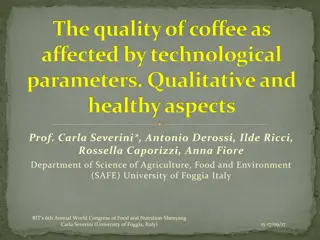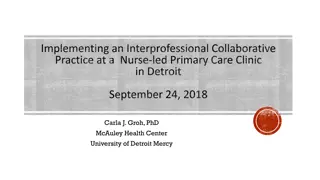
Challenges Faced by Men Post-Prison Release
Explore the complexities of post-prison life for men, focusing on housing, agency, and luck. This qualitative study delves into issues like drug use, recidivism, and the importance of stable housing post-release. Preliminary findings highlight the overwhelming transition from prison to the real world.
Uploaded on | 0 Views
Download Presentation

Please find below an Image/Link to download the presentation.
The content on the website is provided AS IS for your information and personal use only. It may not be sold, licensed, or shared on other websites without obtaining consent from the author. If you encounter any issues during the download, it is possible that the publisher has removed the file from their server.
You are allowed to download the files provided on this website for personal or commercial use, subject to the condition that they are used lawfully. All files are the property of their respective owners.
The content on the website is provided AS IS for your information and personal use only. It may not be sold, licensed, or shared on other websites without obtaining consent from the author.
E N D
Presentation Transcript
Housing, agency and luck in a qualitative study of men in the post-prison release period Carla Treloar1, Annie Madden1, Eileen Baldry2, Peter Higgs3, Paul Dietze4, Mark Stoove4 1CSRH, UNSW 2SOSS, UNSW 3La Trobe University 4Burnet Institute
Transitions post-release Complex intersection Health Social Criminogenic factors Drug use High rates of drug use history among prisoners High rates of recidivism Issues beyond drug use Physical and mental health Housing associations with return to prison Other indicators of disadvantage unemployment, debt Need a sophisticated approach Unpack trajectories Inform responses
Methods design Large NHMRC-funded project Innovative design, positive deviance approach Individual, social relationships, structural conditions Post-release housing status Vulnerable Stable Transient Post-release drug use No use of illicit drugs Illicit drug use, no injecting Injecting drug use 10 10 10 30 10 10 10 30 10 10 10 30 30 30 30 90 Qual data will also inform data linkages questions
This project A qualitative pilot study, n=15 Piggy-back from PATH cohort Men released from Victorian prisons All with histories of injecting drug use Recruited 2 weeks 22 months post-release Recruited from Melbourne metro
This project Sample achieved Post-release housing status Vulnerable Stable Transient Post-release drug use No use of illicit drugs Illicit drug use, no injecting Injecting drug use 1 1 0 2 0 0 0 0 4 5 4 13 5 6 4 15
Preliminary findings Release from prison can be overwhelming, an assault on all the senses, how to cope? Like before I was out of prison, I spent the most of the last end of the sentence in the slot. So I got out from being locked down for 23 hours a day, to everything just like my mum was driving at 60 km s down the road leaving the prison and I was like holding onto the roof of the car and Stop flying and that, I m doing the speed limit, it s only 60km s I was freaking out. It s hard to just get thrown out into the real world. Even just walking through the city at the time, you know the commotion, I was freaking out. It was too much. Massive headache. And clean air there and then all of a sudden, all this pollution. It s probably why everyone ends back in. They end up getting straight back into the drugs just to be able to adapt and then all of a sudden, before you know it they were doing the same shit they were before they went in. (#1, 35 years, last sentence 5 years, unstable housing)
Preliminary findings Pre-release planning absent, unhelpful And when you were coming up for release from prison, did you find the prison services were helpful for planning your release or did you do that mostly yourself? They were shit. I got fuck all help. I got [public transport pass] and my Medicare card. So did you ask for help and not get it? Yeah, they said it s being processed , it s being processed , but it never happened. (#10, 38 years, last sentence 11 months, living with partner)
Preliminary findings Post-release services absent, managed by luck Yeah, but I had to organize the mental health worker myself. I m lucky I ve got a really good proactive parole officer, but she could turn around and say, I don t care . Instead, she s the one who got me the housing worker. I can sit down and talk to her about anything and we nut it out. She knows about my doctor. They even have care meetings, where it s my parole officer, my mental health worker, my housing worker, my doctor, they all get together once a month and we are all on the right page here and yeah. (#3, 52 years, last sentence 12.5 years, sleeping on ex-partner s couch)
Preliminary findings Probation and parole support vs pressure What sort of support or help do you get from probation and parole? Yeah, they call it support. I call it pressure. At first I didn t think there was any support at all, but now that I ve gotten to know my officer, it s okay, she s working with me now, she knows about my health, getting the cure for hepatitis. Like if I wasn t me, I d be in prison, I would ve been back in prison ages ago, because the way my parole, no one can handle this while working. I ve been lucky too with family, with family friends, they know the situation, they ll let me leave but in the end it didn t work out. They say it s all fine, but when you get a phone call, you have to go do a urine now and you re the only one in the shop and you have to close the shop and they re not making money and they can t pay the wages, they just say oh look I can t do this . (#12, 35 years, last sentence 3 years 3 months, living with partner)
Preliminary findings The intersection of accommodation and drug use I sort of knew I would find somewhere to stay, but the risk of using was increased by who I stayed with and there wasn t pretty much anyone left you know from years ago that came back to me and then went away and then wanted to come back again, so I didn t have too many places to go (#9, 47 years, last sentence 9 months, couch surfing) If I stuff up, there s a chance that she can just turn around and say, pack your stuff and go home , so that s why I m not doing drugs or I m not going down that path. (#15, 32 years, last sentence 6 months, living with ex-partner and their children)
Preliminary findings The intersection of accommodation and drug use That s the reason I stayed out so long, is I got housing through [a release support program] in jail. That was the last time. It wasn t this time. They found me a house and I lived there for 5 years and because my housing was good, my life was good you know. Everything else fell into place. Then I [was physically attacked and my house was robbed] and things started to go a bit pear-shaped after that, I started using again and ended up in jail. (#10, 38 years, last sentence 11 months, living with a parent and girlfriend) I went to [a supported accommodation service] from release, I was there for roughly about 8 weeks. I had an incident there I ended up being on the streets for 6 days in that 6-7 days I did use, my drug of choice is ice so you know, being so angry and frustrated I did the 7 days, I did the binge thing, I did the drugs every day for 7 days (#13, 48 years, last sentence 4.5 years, living at supported accommodation)
Preliminary findings Agency in making things happen, help but not help once I got out and I was at my parents for the 4 days, I rang the jail back and asked them how do I go about getting accommodation now I ve just been released from jail, they told me to go to [a particular block of housing flats] and it s full of jail birds. Everyone who s on parole just goes there. I just thought, no, not happening , so I ended up on the streets. (#6, 43 years, last sentence 2 years, homeless)
Other themes to explore Masculinities, relationships Providers , relationships with ex/partners and children (housing) Cumulative disadvantage Poverty, deprivation, exclusion, life course and stratification Co-occur: produce deep social disadvantage Multiple, interlocking social identities o individual reflect macro-level structural inequality Complex support needs left to CJ system to manage (or not) Create a structural pathway to re-imprisonment
Other themes to explore Systemic failures of support Boundaries between services No one s problem , no coordination of multiple care needs Individualises the problem, obscures structural Transitions and drug use Violence, unplanned housing moves, social dislocations Drug use in prison b/c inadequate in-prison AOD programs Visibility (homelessness) assoc with increased policing Next steps Beginning 3 year NHMRC grant to complete sample
Acknowledgements Funding UNSW Gold Star Award Colleagues: Paul Dietze, Mark Stoove, Eileen Baldry, Peter Higgs, Annie Madden, Lise Lafferty PATH Cohort Study Field work team at Burnet Institute Participants





